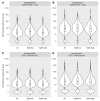Immunological and molecular features of the tumor microenvironment of long-term survivors of ovarian cancer
- PMID: 39470729
- PMCID: PMC11645148
- DOI: 10.1172/JCI179501
Immunological and molecular features of the tumor microenvironment of long-term survivors of ovarian cancer
Abstract
BACKGROUNDDespite an overall poor prognosis, about 15% of patients with advanced-stage tubo-ovarian high-grade serous carcinoma (HGSC) survive 10 or more years after standard treatment.METHODSWe evaluated the tumor microenvironment of this exceptional, understudied group using a large international cohort enriched for long-term survivors (LTS; 10+ years; n = 374) compared with mid-term (MTS; 5-7.99 years; n = 433) and short-term survivors (STS; 2-4.99 years; n = 416). Primary tumor samples were immunostained and scored for intraepithelial and intrastromal densities of 10 immune-cell subsets (including T cells, B cells, plasma cells, myeloid cells, PD-1+ cells, and PD-L1+ cells) and epithelial content.RESULTSPositive associations with LTS compared with STS were seen for 9 of 10 immune-cell subsets. In particular, the combination of intraepithelial CD8+ T cells and intrastromal B cells showed near 5-fold increased odds of LTS compared with STS. All of these associations were stronger in tumors with high epithelial content and/or the C4/Differentiated molecular subtype, despite immune-cell densities generally being higher in tumors with low epithelial content and/or the C2/Immunoreactive molecular subtype.CONCLUSIONThe tumor microenvironment of HGSC LTS is distinguished by the intersection of T and B cell coinfiltration, high epithelial content, and C4/differentiated molecular subtype, features which may inspire new approaches to immunotherapy.FUNDINGOvarian Cancer Research Program (OCRP) of the Congressionally Directed Medical Research Program (CDMRP), U.S. Department of Defense (DOD); American Cancer Society; BC Cancer Foundation; Canada's Networks of Centres of Excellence; Canadian Cancer Society; Canadian Institutes of Health Research; Cancer Councils of New South Wales, Victoria, Queensland, South Australia, and Tasmania, Cancer Foundation of Western Australia; Cancer Institute NSW; Cancer Research UK; Deutsche Forschungsgesellschaft; ELAN Funds of the University of Erlangen-Nuremberg; Fred C. and Katherine B. Andersen Foundation; Genome BC; German Cancer Research Center; German Federal Ministry of Education and Research, Programme of Clinical Biomedical Research; Instituto de Salud Carlos III; Mayo Foundation; Minnesota Ovarian Cancer Alliance; Ministerio de Economía y Competitividad; Medical Research Council (MRC); National Center for Advancing Translational Sciences; National Health and Medical Research Council of Australia (NHMRC); Ovarian Cancer Australia; Peter MacCallum Foundation; Sydney West Translational Cancer Research Centre; Terry Fox Research Institute; The Eve Appeal (The Oak Foundation); UK National Institute for Health Research Biomedical Research Centres at the University of Cambridge; University of Pittsburgh School of Medicine; U.S. National Cancer Institute of the National Institutes of Health; VGH & UBC Hospital Foundation; Victorian Cancer Agency.
Keywords: Cancer; Cellular immune response; Epidemiology; Immunology; Oncology.
Figures






Comment in
- Immune-molecular interactions in high-grade serous ovarian cancer distinguish long-term survivors
References
MeSH terms
Substances
Grants and funding
- R21 CA267050/CA/NCI NIH HHS/United States
- R01 CA087538/CA/NCI NIH HHS/United States
- R01 CA058598/CA/NCI NIH HHS/United States
- UL1 TR000124/TR/NCATS NIH HHS/United States
- P50 CA105009/CA/NCI NIH HHS/United States
- K07 CA080668/CA/NCI NIH HHS/United States
- P30 CA008748/CA/NCI NIH HHS/United States
- MC_UU_00004/01/MRC_/Medical Research Council/United Kingdom
- 10119/CRUK_/Cancer Research UK/United Kingdom
- UL1 TR001881/TR/NCATS NIH HHS/United States
- 10124/CRUK_/Cancer Research UK/United Kingdom
- P30 CA046592/CA/NCI NIH HHS/United States
- M01 RR000056/RR/NCRR NIH HHS/United States
- R01 CA095023/CA/NCI NIH HHS/United States
- R01 CA054419/CA/NCI NIH HHS/United States
- R01 CA122443/CA/NCI NIH HHS/United States
- P30 CA015083/CA/NCI NIH HHS/United States
- P30 CA071789/CA/NCI NIH HHS/United States
- R01 CA112523/CA/NCI NIH HHS/United States
- P50 CA136393/CA/NCI NIH HHS/United States
LinkOut - more resources
Full Text Sources
Medical
Research Materials
Miscellaneous

